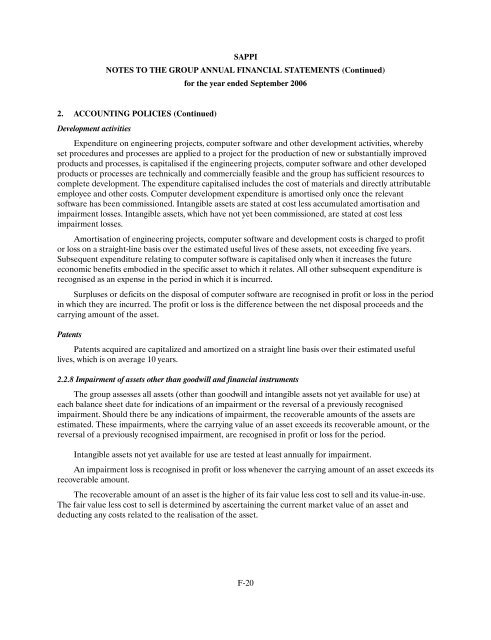Create successful ePaper yourself
Turn your PDF publications into a flip-book with our unique Google optimized e-Paper software.
SAPPI<br />
NOTES TO THE GROUP ANNUAL FINANCIAL STATEMENTS (Continued)<br />
for the year ended September <strong><strong>20</strong>06</strong><br />
2. ACCOUNTING POLICIES (Continued)<br />
Development activities<br />
Expenditure on engineering projects, computer software and other development activities, whereby<br />
set procedures and processes are applied to a project for the production of new or substantially improved<br />
products and processes, is capitalised if the engineering projects, computer software and other developed<br />
products or processes are technically and commercially feasible and the group has sufficient resources to<br />
complete development. The expenditure capitalised includes the cost of materials and directly attributable<br />
employee and other costs. Computer development expenditure is amortised only once the relevant<br />
software has been commissioned. Intangible assets are stated at cost less accumulated amortisation and<br />
impairment losses. Intangible assets, which have not yet been commissioned, are stated at cost less<br />
impairment losses.<br />
Amortisation of engineering projects, computer software and development costs is charged to profit<br />
or loss on a straight-line basis over the estimated useful lives of these assets, not exceeding five years.<br />
Subsequent expenditure relating to computer software is capitalised only when it increases the future<br />
economic benefits embodied in the specific asset to which it relates. All other subsequent expenditure is<br />
recognised as an expense in the period in which it is incurred.<br />
Surpluses or deficits on the disposal of computer software are recognised in profit or loss in the period<br />
in which they are incurred. The profit or loss is the difference between the net disposal proceeds and the<br />
carrying amount of the asset.<br />
Patents<br />
Patents acquired are capitalized and amortized on a straight line basis over their estimated useful<br />
lives, which is on average 10 years.<br />
2.2.8 Impairment of assets other than goodwill and financial instruments<br />
The group assesses all assets (other than goodwill and intangible assets not yet available for use) at<br />
each balance sheet date for indications of an impairment or the reversal of a previously recognised<br />
impairment. Should there be any indications of impairment, the recoverable amounts of the assets are<br />
estimated. These impairments, where the carrying value of an asset exceeds its recoverable amount, or the<br />
reversal of a previously recognised impairment, are recognised in profit or loss for the period.<br />
Intangible assets not yet available for use are tested at least annually for impairment.<br />
An impairment loss is recognised in profit or loss whenever the carrying amount of an asset exceeds its<br />
recoverable amount.<br />
The recoverable amount of an asset is the higher of its fair value less cost to sell and its value-in-use.<br />
The fair value less cost to sell is determined by ascertaining the current market value of an asset and<br />
deducting any costs related to the realisation of the asset.<br />
F-<strong>20</strong>
















